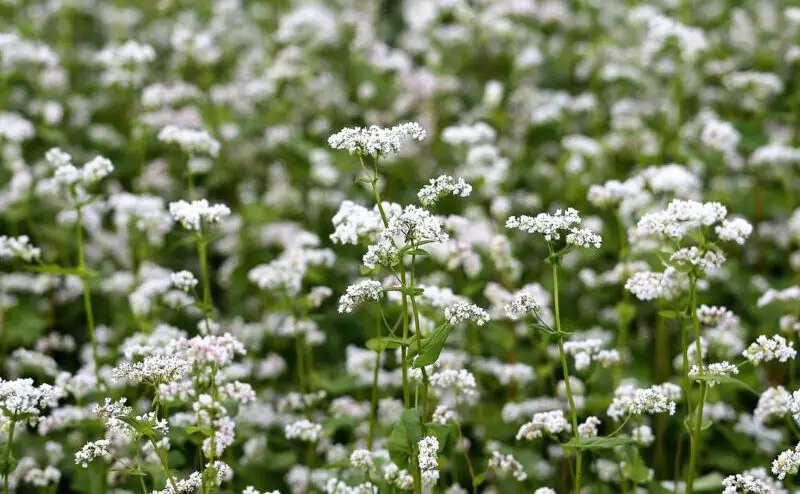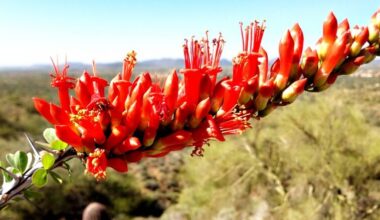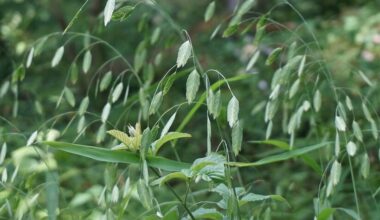Buckwheat (Fagopyrum esculentum), or buckwheat, is not a cereal but a polygonaceae that is easy to bring into the vegetable garden, either as a green manure or for the cultivation of its seeds.
You will choose buckwheat as a green manure especially if you want to weed an area that has been left uncultivated and that is invaded by weeds: a buckwheat sowing in spring or summer will take over the weeds and prevent them from developing, because it is very fast growing. When the buckwheat reaches 8 inches in height, and before it goes to seed, you mow it, leaving the material on the ground and then clawing it into the soil.
Buckwheat is a non-hardy annual with an upright habit that can reach 24 inches in height, with branched, reddish stems, alternate dark green, triangular or heart-shaped leaves measuring 2 inches long, and fragrant white flowers blooming in small terminal clusters during the summer.
Contents
Planting Buckwheat
Where to plant buckwheat?
In the sun, in any soil, even poor.
When and how to plant buckwheat?
Sow from the end of April, after all risk of frost has passed, to the end of June.
- While buckwheat is content with poor soil, it likes well-prepared, well-crumbled soil.
- Make furrows 6 inches apart, and space the seeds every 2 inches, buried at 1 inch.
- Buckwheat likes compacted soil: pack the soil, and water abundantly.
Preparing the soil before sowing
Buckwheat is content with poor soil. This is one of the reasons why farmers used it in the past.
The soil must be finely spaded and weeded so that the buckwheat does not compete with weeds during its growth. A well-crumbled soil will allow the seeds to start growing better.
When to sow buckwheat?
Buckwheat is sown from the end of April to the end of June, after the last frosts (dates vary according to region).
Place a buckwheat seed every 2 inches, 1 inch deep. The rows are spaced about 6 inches apart. Buckwheat likes compacted soil; pack the soil after sowing.
Finally, as the seed coat is quite hard, water generously to facilitate germination (be careful with sub-zero temperatures).
Cultivation and maintenance of buckwheat
The plant grows quickly, without any particular requirements:
- Water if it does not rain.
- Weeding is not necessary, the plant being very covering.
When and how to harvest buckwheat?
If you have grown buckwheat as a green manure, dig it in as soon as it flowers, before the seeds appear. It brings carbon to the soil. You can also use it as a mulch, just after the installation of various young plants, or at the foot of shrubs, always before the arrival of seeds.
In September, the buckwheat grains mature, but not all at the same time, which requires a lot of patience to harvest. Difficult to mechanize, this harvest explains in large part the abandonment of buckwheat cultivation. The best way to harvest buckwheat in the garden is to mow the plants and let them dry in the sun, then to beat them over a canvas.
The conservation of buckwheat
Keep the seeds dry in paper or canvas envelopes.
Diseases, pests and parasites
No enemies are known. Simply, the stems are brittle and it is necessary to weed with delicacy.
Frileux, buckwheat may be sensitive to a drop in temperature.
Is buckwheat a cereal?
Cereals are mainly plants of the Poaceae family (which was called Grasses not so long ago), like wheat or barley.
But other plants, whose seeds are consumed, are assimilated to cereals, such as buckwheat or buckwheat, which belongs to the Polygonaceae family, amaranth to the Amaranthaceae family, quinoa to the Chenopodiaceae family, like spinach. They are sometimes referred to as pseudo-cereals, to differentiate them from classic cereals. For this reason, the nutritional composition of buckwheat differs from that of the latter, because it is gluten-free and richer in protein. However, it is consumed as a cereal.
While buckwheat is not widely used in Western Europe, where it is mostly found in organic stores and in the flour used to make pancakes, it is popular in Japan, Russia and Eastern and Central Europe. Buckwheat grains can be eaten whole, roasted or crushed, or in the form of flours used in pancakes, breads and noodles, known as “soba”.









